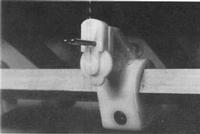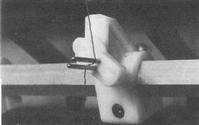


Chapter 5
I 1788 - State Of The Art In Textile Technology
II Australian Textiles - The Early Days
III Australian Textiles - The 20th Century
i Technology and Development
ii Australian Wool Textile Research
IV Australian Textiles - To Date
V Acknowledgements
References
Index
Search
Help
Contact us

Australian Wool Textile Research (continued)
The reason for the twofolding stage is that single worsted yarns will not weave. They are too hairy, and their surface abrasion resistance is not high enough to enable them to survive the abrasion forces they experience on the weaving machine. The poor abrasion resistance arises because of fibre on the surface of the yarn has a high probability of lying on the surface for a substantial part of its length, and thus can be readily abraded away. Twofolding overcomes the problem by twisting two yarns together in such a way that the surface fibres are trapped between the two yarns. The twofold yarn then has sufficient abrasion resistance to enable it to be woven. An important point to note here is that, to achieve trapping of the surface fibres, the two component yarns must not only be twisted about each other, they must also individually contain twist. Twofolding of two untwisted yarns gives a structure in which the surface fibres are not trapped, but are on the surface of the twofold yarn for its entire length. In fact, methods for producing a two-strand yarn in one operation on a spinning frame had been tried previously, but without any notable success.CSIRO researchers,[51] recognizing the requirements outlined above for the structure for such a yarn, undertook a study of the mechanisms needed to impart individual strand-twist while concurrently folding two strands together. Feeding two, separated strands together on to one spindle, they showed that, if the twist equilibrium at the point at which the two strands converge is disturbed, it is possible to trap small amounts of alternating twist in each of the strands while the strands are twisted together. This produces in one operation a yarn with some characteristics of a single yarn but one in which surface fibres are adequately trapped to withstand the abrasive forces on a weaving machine.
At first, very simple mechanisms were developed to cause this disturbance, but practical work in industry in collaboration with the International Wool Secretariat (I.W.S.) showed that even this was unnecessary, and that, provided that the spacing between the rovings was optimised,[52] a structure with sufficient fibre entrapment for weaving could be produced.
In applying this important breakthrough in knowledge to commercial spinning, there was another difficult practical problem to solve. In spinning two strands together, if one strand breaks, or the supply material for one strand runs out, the remaining strand can continue to run by itself. This produces a section of yarn that is thinner than the rest, is difficult to detect automatically, and, if allowed to reach the fabric, produces a fault that is expensive to repair. The problem was overcome by the development of a simple device that automatically detects the breaking of one strand and then instantaneously breaks out the remaining strand. The mechanism of the breakout device (Fig. 24) relies on blockage of the twist rising up the yarn from the spindle. This reduces the cohesion of the fibres, and the forming yarn breaks.


Organisations in Australian Science at Work - CSIRO; CSIRO Division of Protein Chemistry; CSIRO Division of Textile Industry; International Wool Secretariat (I.W.S.)
 |
Australian Academy of Technological Sciences and Engineering |  |
© 1988 Print Edition pages 294 - 295, Online Edition 2000
Published by Australian Science and Technology Heritage Centre, using the Web Academic Resource Publisher
http://www.austehc.unimelb.edu.au/tia/296.html